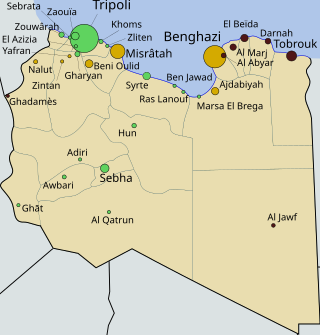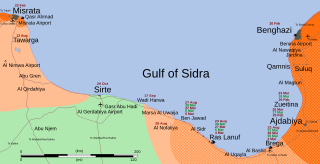Zawiya, officially Zawia, is a city in northwestern Libya, situated on the Libyan coastline of the Mediterranean Sea about 47 km (29 mi) west of Tripoli, in the historic region of Tripolitania. Zawiya is the capital of the Zawiya District.

Gharyan is a city in northwestern Libya, in Jabal al Gharbi District, located 80 km south of Tripoli. Gharyan is one of the largest towns in the district. Prior to 2007, it was the administrative seat of Gharyan District.

The Tripoli protests and clashes were a series of confrontations between Libyan anti-government demonstrators and forces loyal to Libyan leader Muammar Gaddafi in the capital city of Tripoli that took place in February 2011, at the beginning of the Libyan civil war. During the early days of the uprising, there was significant unrest in the city, but the city remained under the control of the government.

The Libyan Civil War began on 17 February 2011 as a civil protest and later evolved into a widespread uprising. By mid-August, anti-Gaddafi forces effectively supported by a NATO-led international coalition were ascendant in Tripolitania, breaking out of the restive Nafusa Mountains in the south to mount an offensive toward the coast and advancing from Misrata on loyalist-held cities and villages from the north and east.

The National Liberation Army, officially the National Liberation Armed Forces of the Free Libyan Republic, formerly known as the Free Libyan Army, was a Libyan military organisation affiliated with the National Transitional Council, which was constituted during the First Libyan Civil War by defected military members and civilian volunteers, in order to engage in battle against both remaining members of the Libyan Armed Forces and paramilitia loyal to the rule of Muammar Gaddafi. Its self proclaimed chief commander was General Khalifa Haftar, although the National Transitional Council preferred to appoint Major General Abdul Fatah Younes Al-Obeidi as its commander-in-chief. It had prepared for some time in portions of Eastern Libya controlled by the anti-Gaddafi forces for eventual full-on combat in Western Libya against pro-Gaddafi militants, training many men before beginning to go on the offensive. They have battled for control of Benghazi, Misrata, Brega, Ajdabiya, Zawiya and Ra's Lanuf as well as several towns in the Nafusa Mountains. They finally began the Battle for Tripoli in August 2011 when they attacked from the west of the city, as well as fomenting an internal uprising on 20 August.
The Battle of Ras Lanuf was a two-phase battle in 2011 during the Libyan Civil War between forces loyal to Libyan leader Muammar Gaddafi and those loyal to the National Transitional Council. Both forces sought control of the town of Ras Lanuf. The first phase followed two days after the First Battle of Brega which occurred in the town Brega, roughly 130 kilometres (81 mi) to the east of Ras Lanuf. After conquering the town on 4 March, the rebels pushed further west to attack Sirte but they were driven back by government forces and on 11 March, government troops reconquered most of Ras Lanuf.
The Nafusa Mountains campaign was a series of battles in the Libyan Civil War, fought between loyalist pro-Gaddafi forces and rebel anti-Gaddafi forces in the Nafusa Mountains and, at a later period, in the surrounding plains of western Libya. The mountain range is of strategic importance due to its close proximity to the capital of Tripoli. Along with the city of Misrata, the Nafusa Mountains region was one of the major rebel strongholds in Tripolitania.
The Battle of the Misrata frontline was a battle during the Libyan Civil War between pro-Gaddafi loyalists and anti-Gaddafi forces on the western and southwestern outskirts of Misrata, the third largest city in Libya. It ended when anti-Gaddafi soldiers secured Zliten to the west and Tawergha to the south, establishing a significant buffer zone around the city.
The Zawiya skirmish began on 11 June 2011, when the National Liberation Army launched an attack into the coastal city of Zawiya, Libya in an attempt to recapture it from army units and militiamen loyal to Muammar Gaddafi. The attack was quickly crushed by the numerically superior and better-equipped loyalist forces, who had taken the city earlier in the Libyan Civil War after defeating rebel forces in a major battle that lasted from February to March 2011.
The Second Battle of Zawiya or Zawia took place during the Libyan Civil War between rebel anti-Gaddafi forces and forces loyal to Muammar Gaddafi for control of the Tripolitanian city of Zawia.
Al-Qawalish is a village in the Nafusa Mountains of Libya, located about 113 kilometres (70 mi) southwest of Libya's capital Tripoli. Al-Qawalish is divided into two parts: west Al-Qawalish and east Al-Qawalish, separated by a canyon and is home to approximately 7,000 people.

The Libyan Civil War began on 15 February 2011 as a chain of civil protests and later evolved into a widespread uprising against the regime of Muammar Gaddafi. On 25 February, most of eastern Libya was reported to be under the control of protesters and rebel forces. Gaddafi remained in control of the cities of Tripoli, Sirte and Sabha. By 15 March, however, Gaddafi's forces had retaken more than half a dozen lost cities. Except for most of Cyrenaica and a few Tripolitania cities the majority of cities had returned to Gaddafi government control.

The timeline of the Libyan civil war begins on 15 February 2011 and ends on 20 October 2011. The conflict began with a series of peaceful protests, similar to others of the Arab Spring, later becoming a full-scale civil war between the forces loyal to Muammar Gaddafi's government and the anti-Gaddafi forces. The conflict can roughly be divided into two periods before and after external military intervention authorized by United Nations Security Council Resolution 1973.

The Tripoli Revolutionaries Brigade or Free Tripoli Guardian was a unit of the National Liberation Army of Libya created during the Libyan Civil War that merged into the Tripoli Protection Force. Originally formed in April 2011 in the opposition stronghold of Benghazi, it later relocated to the Nafusa Mountains, then the closest frontline to Tripoli, before advancing into the city itself in August.
The First Battle of Zawiya or Zawia was a battle during the Libyan Civil War between army units and militiamen loyal to Muammar Gaddafi and anti-Gaddafi forces for control of the city of Zawia.
The 2011 Libyan rebel coastal offensive was a major rebel offensive of the Libyan Civil War. It was mounted by anti-Gaddafi forces with the intention of cutting off the supply route from Tunisia for pro-Gaddafi loyalist forces in Tripoli.

The Battle of Tripoli, sometimes referred to as the Fall of Tripoli, was a military confrontation in Tripoli, Libya, between loyalists of Muammar Gaddafi, the longtime leader of Libya, and the National Transitional Council, which was attempting to overthrow Gaddafi and take control of the capital. The battle began on 20 August 2011, six months after the First Libyan Civil War started, with an uprising within the city; rebel forces outside the city planned an offensive to link up with elements within Tripoli, and eventually take control of the nation's capital.

The Second Gulf of Sidra offensive was a military operation in the First Libyan Civil War conducted by rebel anti-Gaddafi forces in August and September 2011 to take control of towns along the Gulf of Sidra in an effort to surround Muammar Gaddafi's hometown of Sirte, which was held by pro-Gaddafi forces. It ended on 20 October, with the capture and execution of Muammar Gaddafi and his son Mutassim Gaddafi, along with former defense minister Abu-Bakr Yunis Jabr. The Gaddafi loyalists in the area were finally defeated when NTC fighters captured Sirte.

The 2011 Libyan Civil War began on 17 February 2011 as a civil protest and later evolved into a widespread uprising. After a military intervention led by France, the United Kingdom, and the United States on 19 March turned the tide of the conflict at the Second Battle of Benghazi, anti-Gaddafi forces regrouped and established control over Misrata and most of the Nafusa Mountains in Tripolitania and much of the eastern region of Cyrenaica. In mid-May, they finally broke an extended siege of Misrata.

Gaddafi loyalism, in a wider political and social sense also known as the Green resistance, consists of sympathetic sentiment towards the overthrown government of Muammar Gaddafi, who was killed in October 2011, and his Third International Theory. Despite Muammar Gaddafi's death, his legacy and Jamahiriya ideology still maintains a popular appeal both inside and outside Libya into the present day. Regardless, the Western sentiment has largely been that this continued support may contribute to some of the ongoing violence in Libya.








